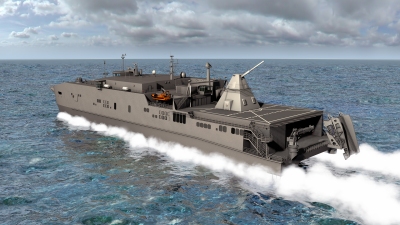Posted on

Students assemble components of Virginia Tech's electromagnetic railgun pulse forming network at the university's Energy Conversion Systems Laboratory. Naval Surface Warfare Center Dahlgren Division (NSWCDD) railgun experts have been advising Virginia Tech students and professors since 2011. "The experience the student gains at Virginia Tech working on relevant railgun work is directly applicable to the skill sets we need to transition this technology into a reality for the Navy," said Chris Reichart, NSWCDD Pulsed Power Branch head.
BLACKSBURG, Va. (Dec. 9, 2015)—Virginia Tech students fired the university's electromagnetic railgun for the first time as their U.S. Navy railgun advisors observed the demonstration here Dec. 4.
The Naval Surface Warfare Center Dahlgren Division (NSWCDD) railgun experts mentored the students throughout the electromagnetic railgun development cycle.
"What Virginia Tech has accomplished here is impressive and an important investment for the nation's railgun development efforts," said Dohn Burnett NSWCDD Deputy Technical Director. "It provides an excellent test bed for research and a very effective way to develop scientists and engineers who will be able to hit the ground running to help field this capability."
NSWCDD engineers advised their Virginia Tech protégés as the students worked on high power systems and project reviews at a Virginia Tech laboratory.
"Working in the Energy Conversion Systems Laboratory provided a unique out-of-the classroom college experience where I was able apply my engineering education to solve real and complex challenges," said Virginia Tech student George Hric. "My experience working with railgun technology inspired me to pursue a career in the defense industry."
In all, the university's reduced-scale railgun program attracted and inspired over 150 students from all engineering disciplines to participate in hands-on research.

An artist rendering showing the Office of Naval Research-funded electromagnetic railgun installed aboard the joint high-speed vessel USNS Millinocket (JHSV 3). The railgun is a long-range weapon that launches projectiles using electricity instead of chemical propellants and is currently undergoing testing at Naval Surface Warfare Center Dahlgren Division.
"The Virginia Tech electromagnetic railgun proved to be an effective recruiting opportunity," said John Wright, an NSWCDD senior engineer and the command's science, technology, engineering and mathematics coordinator. "The seven interns who joined our Pulsed Power Branch last summer significantly contributed to the development of the Navy's Railgun Program."
The collaboration began in 2011 when Naval Engineering Education Center (NEEC) and NSWCDD worked with Virginia Tech professor Hardus Odendaal and his graduate and undergraduate engineering students in their efforts to build a reduced-scale railgun with a novel energy recovery feature.
"The quality of the research aspect cannot be overstated," said Odendaal, an electrical and computer engineering professor specializing in electromagnetics. "Almost every aspect of the railgun system, from the simplest mechanical part to the most complex, such as the circuits for the custom fiber-optic-isolated networked-data-acquisition system printed circuit boards had to be designed, developed, built, and tested from the ground up, including software development."
Although the energy recovery circuit is not complete, the conventional capabilities of Virginia Tech's railgun were proven at the demonstration, according to university and NSWCDD officials.
"The experience the student gains at Virginia Tech working on relevant railgun work is directly applicable to the skill sets we need to transition this technology into a reality for the Navy," said Chris Reichart, NSWCDD Pulsed Power Branch head. "The Virginia Tech students and new hires joining us contribute right away with very little ramp up required."
NSWCDD has also partnered with other universities and colleges - Georgia Tech, Old Dominion University, University of Michigan, and the University of Texas at San Antonio - on projects covering a topics ranging from railgun, unmanned systems and computer science to modeling and simulation, additive manufacturing, and machine vision.
Students studying electromagnetic railgun technology at Virginia Tech represent a diversity of degree programs, including electrical engineering, mechanical engineering, materials science and engineering, civil and environmental engineering, industrial and systems engineering, aerospace and ocean engineering, engineering science and mechanics, computer engineering, chemistry, and geography.
"Each student worked a minimum of 10 hours per week as part of a multidisciplinary team to conduct research, design and assemble parts, lay out circuit boards and test controls, program digital controllers, or produce animations, among other tasks," said Wright. "Students working on the project have designed the railgun projectile catch, a vacuum flash chamber, gate drivers, control system, health monitoring system, and the railgun startup and power-down procedures."
"We developed sensors and systems as well as equipment for testing or calibration such as bore measurement sensing devices and velocity measurement systems," said Odendaal, pointing out that, "one can't just buy railgun parts from a vendor somewhere."
NEEC provides young engineers and scientists access to projects of interest and importance early in their academic careers which builds knowledge and enthusiasm for the field. The students are partnered with trained professionals in the military and private sector to guide them through current projects and to offer insight to post-education opportunities.
NSWCDD, a NAVSEA warfare center division, is a premier research and development center that serves as a specialty site for weapon system integration. The command's unique ability to rapidly introduce new technology into complex warfighting systems is based on its longstanding competencies in science and technology, research and development, and test and evaluation.

